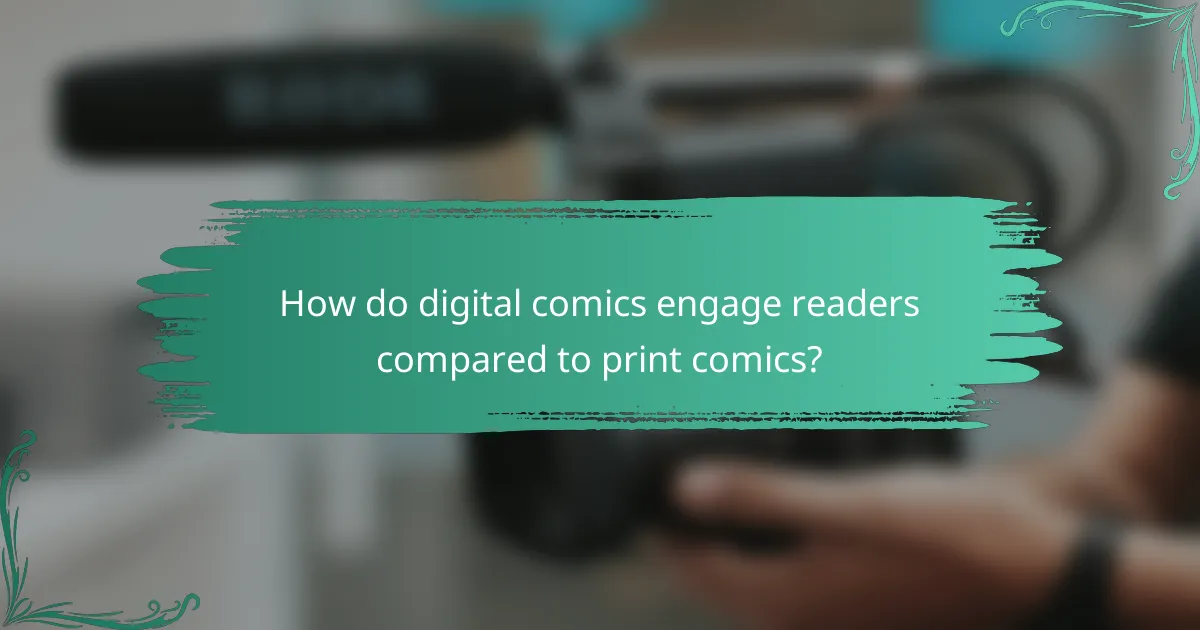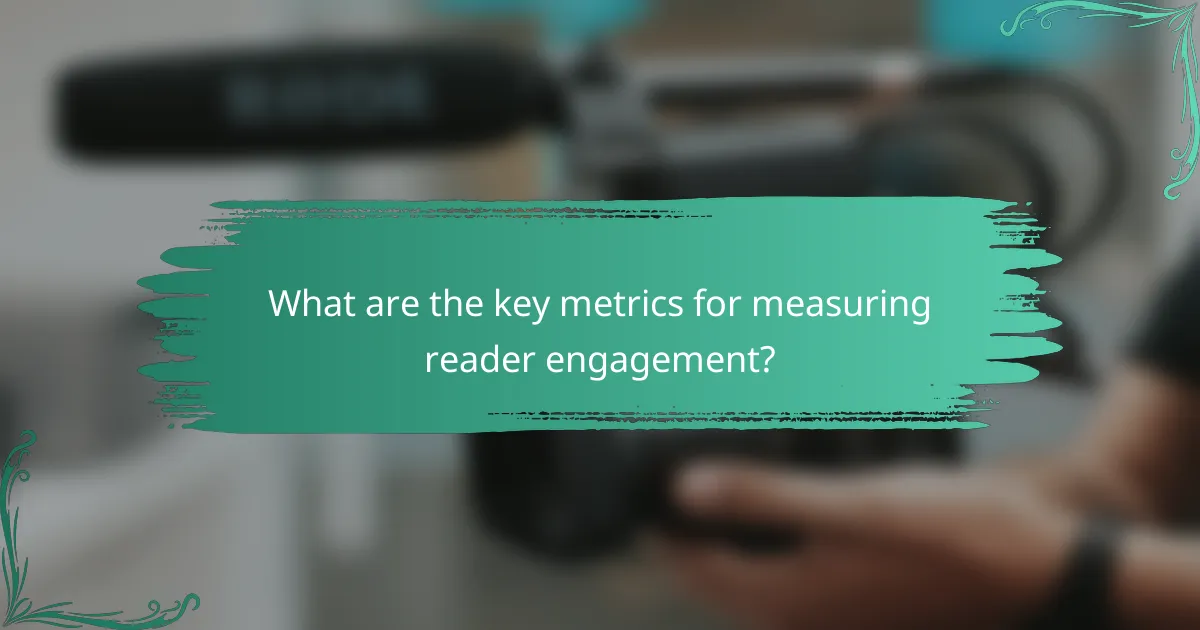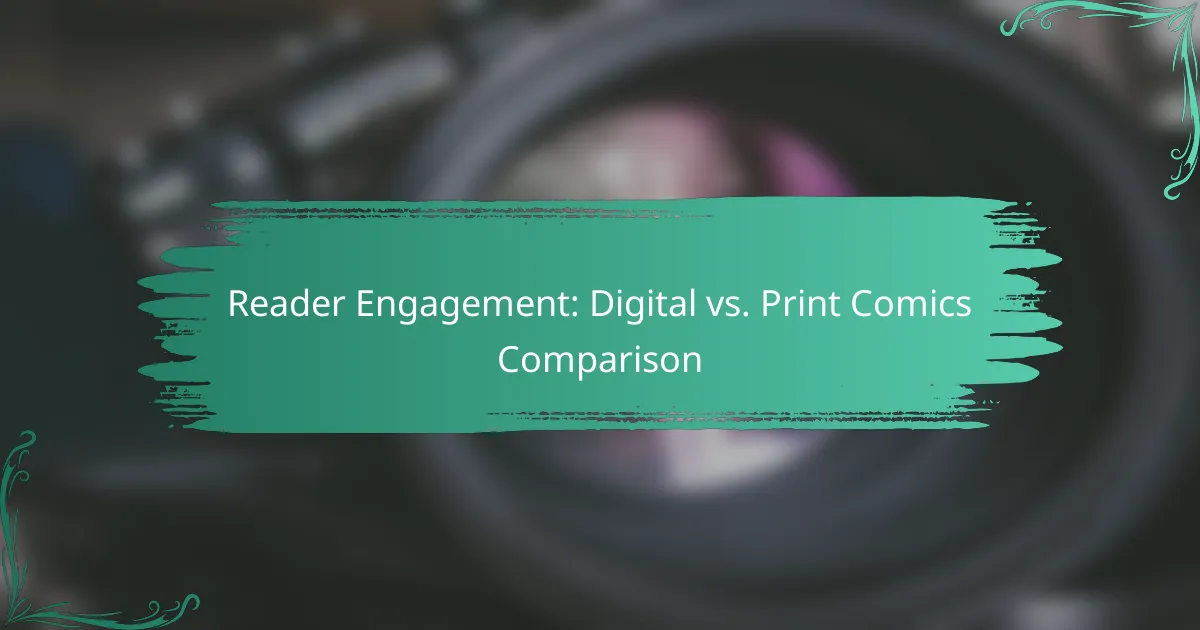The debate between digital and print comics highlights distinct reader engagement experiences shaped by each format’s unique characteristics. Digital comics provide immediate access and interactive features that appeal to modern readers, while print comics deliver a tactile experience and foster community connections. Understanding these differences can help readers choose the format that best suits their preferences and enhances their enjoyment of the medium.

How do digital comics engage readers compared to print comics?
Digital comics engage readers through interactive features and accessibility, while print comics offer a tactile experience and traditional storytelling. Each format has unique strengths that cater to different reader preferences and habits.
Interactive features in digital comics
Digital comics often include interactive elements such as animations, sound effects, and hyperlinks that enhance reader engagement. These features can create a more immersive experience, allowing readers to explore content in ways that print cannot offer.
For example, some digital comics allow readers to click on panels to reveal additional information or alternate storylines. This interactivity can lead to a deeper connection with the narrative and characters.
Visual storytelling in print comics
Print comics excel in visual storytelling through their static yet carefully crafted artwork. The physical pages allow for a unique pacing and flow that can be disrupted in digital formats. Readers often appreciate the artistry and detail that can be fully appreciated on paper.
Moreover, the layout of print comics can guide the reader’s eye in a deliberate manner, enhancing the storytelling experience. The tactile nature of flipping through pages adds to the overall enjoyment of the medium.
Reader accessibility in digital formats
Digital comics are typically more accessible, as they can be read on various devices such as smartphones, tablets, and computers. This convenience allows readers to access a vast library of titles without the need for physical storage.
Additionally, many digital platforms offer features like adjustable text sizes and background colors, catering to readers with different visual needs. This inclusivity can significantly broaden the audience for comics.
Physical experience of print comics
The physical experience of print comics includes the feel of the paper, the smell of the ink, and the satisfaction of holding a tangible product. This sensory engagement can create a stronger emotional connection to the comic.
Collecting print comics can also be a hobby in itself, with many readers valuing first editions or rare issues. This aspect of collecting fosters a community among fans and adds a layer of enjoyment that digital formats may lack.

What are the benefits of digital comics for reader engagement?
Digital comics offer several advantages for reader engagement, including immediate access to diverse content and interactive features that enhance the reading experience. These benefits cater to modern readers’ preferences for convenience and multimedia integration.
Instant access to a wide range of titles
Digital comics provide readers with instant access to a vast library of titles, often surpassing what is available in print. Platforms like ComiXology and Webtoon host thousands of comics, allowing users to explore various genres and styles without geographical limitations.
This accessibility means readers can discover new authors and series easily, often at lower prices or even for free. Subscriptions or pay-per-issue models can offer significant savings compared to purchasing physical copies.
Enhanced interactivity and multimedia elements
Digital comics can incorporate interactive features and multimedia elements that print comics cannot. Readers may experience animations, sound effects, or even interactive panels that enhance storytelling and immersion.
For example, some digital platforms allow readers to tap on panels for additional content, such as character backstories or behind-the-scenes insights. This level of engagement can deepen the reader’s connection to the narrative and characters.
Social sharing capabilities
Digital comics facilitate easy social sharing, allowing readers to discuss and promote their favorite titles on platforms like Twitter, Instagram, or Facebook. This sharing capability can create a sense of community among fans and encourage new readers to explore popular series.
Many digital comic platforms also integrate social features, enabling readers to leave reviews, rate titles, or share recommendations directly within the app. This interaction fosters a vibrant community and enhances overall engagement with the medium.

What are the advantages of print comics for reader engagement?
Print comics offer unique advantages for reader engagement, primarily through their tactile nature, collectible appeal, and the community atmosphere fostered by local comic shops. These factors contribute to a deeper connection between readers and the comic medium.
Tactile experience and collectible value
The tactile experience of holding a print comic enhances reader engagement by appealing to the senses. The feel of the paper, the weight of the book, and the vibrant colors create a physical connection that digital formats often lack.
Additionally, print comics often have collectible value, with first editions or special covers attracting collectors. This aspect can motivate readers to purchase and cherish physical copies, creating a sense of ownership and pride.
Fostering community through local comic shops
Local comic shops serve as hubs for comic enthusiasts, fostering community and engagement. These shops often host events, signings, and discussions that bring readers together, allowing them to share their passion for comics.
Moreover, visiting a comic shop can lead to personal interactions with staff and fellow readers, enhancing the overall experience. This sense of belonging can be a significant factor in a reader’s ongoing engagement with the medium.
Artistic quality in physical formats
Print comics often showcase artistic quality that can be more impactful than digital versions. The larger format and high-quality printing can highlight intricate artwork and colors, making the reading experience more visually appealing.
Furthermore, many artists design their work with print in mind, utilizing techniques that take advantage of physical media. This artistic consideration can elevate the overall enjoyment and appreciation of the comic for readers.

How do reader demographics affect engagement in digital vs. print comics?
Reader demographics significantly influence engagement levels in digital and print comics, with younger audiences gravitating towards digital formats and older readers showing a preference for print. Understanding these trends can help creators and publishers tailor their offerings to better meet the needs of their target demographics.
Younger audiences favor digital comics
Younger readers, often familiar with technology, tend to prefer digital comics due to their accessibility and convenience. Digital platforms allow for instant access to a vast library of titles, often at lower costs compared to print editions.
Additionally, features like interactive elements, animations, and social sharing capabilities enhance the reading experience for this demographic. Many younger readers engage with comics on mobile devices, making digital formats particularly appealing.
Older readers prefer print comics
Older audiences typically favor print comics, valuing the tactile experience and nostalgia associated with physical books. The act of flipping through pages and collecting physical copies is often seen as more satisfying than reading on a screen.
Print comics also allow for a more focused reading experience without the distractions of digital notifications. Many older readers appreciate the quality of printed artwork and the collectible nature of physical comics, which can also hold sentimental value.

What are the key metrics for measuring reader engagement?
Key metrics for measuring reader engagement include page views, reading time, sales figures, and collector interest. These metrics help gauge how effectively comics capture and retain the attention of their audience, whether in digital or print formats.
Page views and reading time for digital comics
For digital comics, page views indicate how many times a comic has been accessed, while reading time reflects how long readers spend on each page. High page views combined with longer reading times suggest strong engagement, as readers are not only clicking through but also absorbing the content.
To enhance engagement, creators should consider optimizing their comics for mobile devices, as a significant portion of digital reading occurs on smartphones. Additionally, incorporating interactive elements can further increase both page views and reading duration.
Sales figures and collector interest for print comics
Sales figures for print comics provide a direct measure of market interest and reader engagement, with higher sales often indicating a more engaged audience. Collector interest, reflected in the demand for rare editions and variants, can also signal strong engagement among dedicated fans.
To boost sales and collector interest, publishers should focus on limited releases and exclusive content, which can create a sense of urgency and desirability. Tracking sales trends over time can help identify which titles resonate most with collectors and casual readers alike.

How do marketing strategies differ for digital and print comics?
Marketing strategies for digital and print comics vary significantly due to the platforms and audience engagement methods involved. Digital comics often leverage targeted ads and social media, while print comics rely more on traditional marketing channels like conventions and physical retail placements.
Targeted ads for digital platforms
Targeted ads for digital platforms focus on reaching specific audience segments based on their online behavior and preferences. Advertisers can utilize tools like Facebook Ads or Google AdWords to create campaigns that target users interested in similar genres or comic-related content.
These ads can be tailored to appear on social media feeds, websites, or within other digital content, maximizing visibility. For instance, a comic about superheroes might target users who follow superhero movies or related merchandise, enhancing the likelihood of engagement.
To optimize targeted ads, creators should regularly analyze performance metrics and adjust their strategies accordingly. Common pitfalls include overly broad targeting or neglecting to A/B test different ad creatives, which can limit effectiveness and return on investment.
